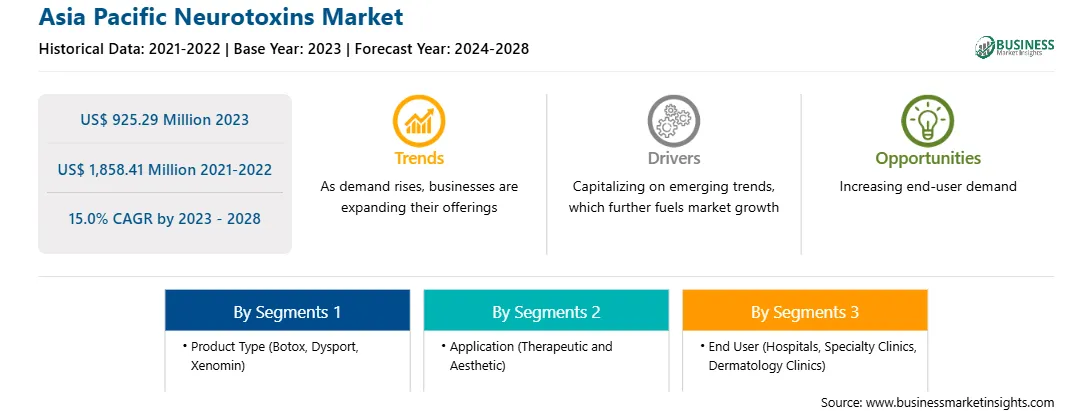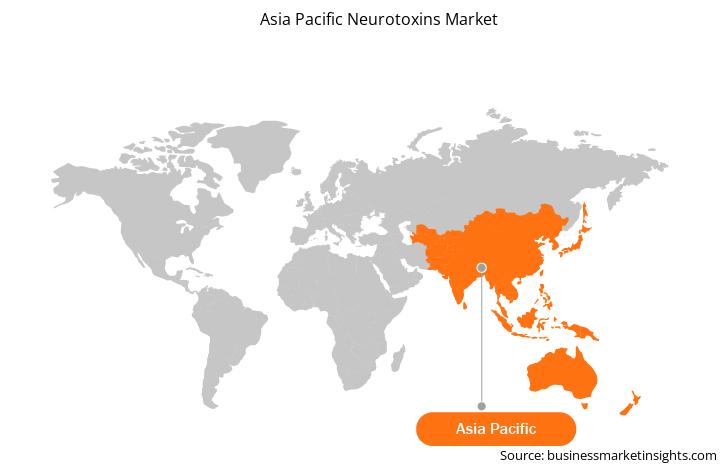Structural changes affecting the skin, muscles, ligaments, fat, and bone get noticeable on an individual’s face due to decrease in cellular functions with aging. The inevitable physiological process of aging is generally not conceived positively by many, which, in turn, urges them to indulge in cosmetic rejuvenation procedures to remain youthful visually. Botulinum toxin (BOTA)—which is naturally produced by Clostridium botulinum—is the most popular neurotoxin used in cosmetic procedures. Therefore, the rising popularity of cosmetic procedures involving neurotoxins to reduce facial wrinkles while ensuring safety, effectivity, and efficiency is catalyzing the market for neurotoxins.
The Asia Pacific neurotoxin market is segmented into China, India, Japan, South Korea, Australia, and the Rest of Asia Pacific. The increasing product developments and launches, growing numbers of aesthetic procedures, rising distribution by companies for neurotoxin products, and increasing demand for non-surgical aesthetic procedures among the young population are driving the growth of the market in the region. The Australian neurotoxin market is expected to have growth opportunities due to growing developments in the pharmaceutical industry. The country has several facilities, such as manufacturing, research and development, and a good distribution network. Also, the country is among the region's top countries performing aesthetic procedures. However, the market for neurotoxins is highly regulated in the country. The botulinum toxin products are classified as S4 pharmaceuticals; hence they are only administered by a doctor or a nurse. Also, the regulatory bodies strictly regulate the products in the country, and the brands approved by Therapeutic Goods Administration (TGA) in Australia are Botox, Dysport, and Xeomin.
Strategic insights for the Asia Pacific Neurotoxins provides data-driven analysis of the industry landscape, including current trends, key players, and regional nuances. These insights offer actionable recommendations, enabling readers to differentiate themselves from competitors by identifying untapped segments or developing unique value propositions. Leveraging data analytics, these insights help industry players anticipate the market shifts, whether investors, manufacturers, or other stakeholders. A future-oriented perspective is essential, helping stakeholders anticipate market shifts and position themselves for long-term success in this dynamic region. Ultimately, effective strategic insights empower readers to make informed decisions that drive profitability and achieve their business objectives within the market. The geographic scope of the Asia Pacific Neurotoxins refers to the specific areas in which a business operates and competes. Understanding local distinctions, such as diverse consumer preferences (e.g., demand for specific plug types or battery backup durations), varying economic conditions, and regulatory environments, is crucial for tailoring strategies to specific markets. Businesses can expand their reach by identifying underserved areas or adapting their offerings to meet local demands. A clear market focus allows for more effective resource allocation, targeted marketing campaigns, and better positioning against local competitors, ultimately driving growth in those targeted areas.Asia Pacific Neurotoxins Strategic Insights

Asia Pacific Neurotoxins Report Scope
Report Attribute
Details
Market size in 2023
US$ 925.29 Million
Market Size by 2028
US$ 1,858.41 Million
Global CAGR (2023 - 2028)
15.0%
Historical Data
2021-2022
Forecast period
2024-2028
Segments Covered
By Product Type
By Application
By End User
Regions and Countries Covered
Asia-Pacific
Market leaders and key company profiles
Asia Pacific Neurotoxins Regional Insights

Asia Pacific Neurotoxins Market Segmentation
The Asia Pacific neurotoxins market is segmented into product type, application, end user, and country.
Based on product type, the Asia Pacific neurotoxins market is subsegmented into botox, dysport, xenomin, and others. The botox segment registered the largest market share in 2023.
Based on application, the Asia Pacific neurotoxins market is segmented into therapeutic and aesthetic. The therapeutic segment held a larger market share in 2023.
Based on end user, the market is segmented into hospitals, specialty clinics, dermatology clinics, and others. The hospitals segment held the largest market share in 2023.
Based on country, the market is segmented into China, India, Japan, South Korea, Australia, and the rest of Asia Pacific. Japan dominated the market share in 2023.
AbbVie Inc, Gufic, Hugel Inc, Ipsen SA, Lanzhou Institute of Biological Products Co Ltd, Medytox Inc, and Merz Pharma GmbH & Co KGaA are among the leading companies operating in the Asia Pacific neurotoxins market.
The Asia Pacific Neurotoxins Market is valued at US$ 925.29 Million in 2023, it is projected to reach US$ 1,858.41 Million by 2028.
As per our report Asia Pacific Neurotoxins Market, the market size is valued at US$ 925.29 Million in 2023, projecting it to reach US$ 1,858.41 Million by 2028. This translates to a CAGR of approximately 15.0% during the forecast period.
The Asia Pacific Neurotoxins Market report typically cover these key segments-
The historic period, base year, and forecast period can vary slightly depending on the specific market research report. However, for the Asia Pacific Neurotoxins Market report:
The Asia Pacific Neurotoxins Market is populated by several key players, each contributing to its growth and innovation. Some of the major players include:
The Asia Pacific Neurotoxins Market report is valuable for diverse stakeholders, including:
Essentially, anyone involved in or considering involvement in the Asia Pacific Neurotoxins Market value chain can benefit from the information contained in a comprehensive market report.